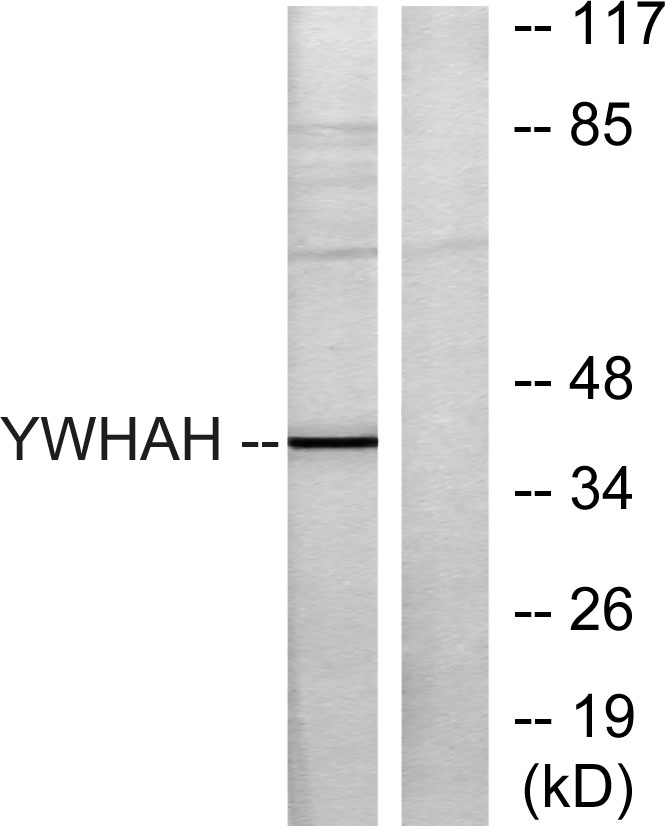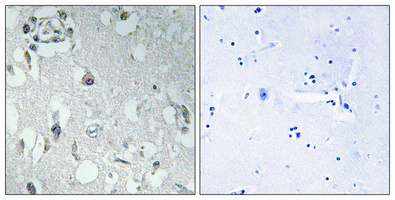产品名称
14-3-3 η Rabbit Polyclonal Antibody
别名
YWHAH; YWHA1; 14-3-3 protein eta; Protein AS1
存储缓冲液
Liquid in PBS containing 50% glycerol, 0.5% BSA and 0.02% New type preservative N.
Human Gene Link
http://www.ncbi.nlm.nih.gov/sites/entrez?db=gene&term=7533
Human Swissprot No.
Q04917
Human Swissprot Link
http://www.uniprot.org/uniprotkb/Q04917/entry
Mouse Gene Link
http://www.ncbi.nlm.nih.gov/sites/entrez?db=gene&term=22629
Mouse Swissprot No.
P68510
Mouse Swissprot Link
http://www.uniprot.org/uniprot/P68510
Rat Gene Link
http://www.ncbi.nlm.nih.gov/sites/entrez?db=gene&term=25576
Rat Swissprot Link
http://www.uniprot.org/uniprot/P68511
免疫原
The antiserum was produced against synthesized peptide derived from human 14-3-3 eta. AA range:51-100
特异性
14-3-3 η Polyclonal Antibody detects endogenous levels of 14-3-3 η protein.
稀释度
WB 1:500 - 1:2000. IHC 1:100 - 1:300. IF 1:200 - 1:1000. ELISA: 1:5000. Not yet tested in other applications.
宿主
Polyclonal, Rabbit,IgG
背景介绍
This gene product belongs to the 14-3-3 family of proteins which mediate signal transduction by binding to phosphoserine-containing proteins. This highly conserved protein family is found in both plants and mammals, and this protein is 99% identical to the mouse, rat and bovine orthologs. This gene contains a 7 bp repeat sequence in its 5' UTR, and changes in the number of this repeat have been associated with early-onset schizophrenia and psychotic bipolar disorder. [provided by RefSeq, Jun 2009],
组织表达
Expressed mainly in the brain and present in other tissues albeit at lower levels.
细胞定位
cytoplasm,mitochondrion,cytosol,plasma membrane,intercalated disc,cytoplasmic vesicle membrane,extracellular exosome,
信号通路
Cell_Cycle_G1S;Cell_Cycle_G2M_DNA;Oocyte meiosis;Neurotrophin;
功能
function:Adapter protein implicated in the regulation of a large spectrum of both general and specialized signaling pathway. Binds to a large number of partners, usually by recognition of a phosphoserine or phosphothreonine motif. Binding generally results in the modulation of the activity of the binding partner.,similarity:Belongs to the 14-3-3 family.,subunit:Homodimer (By similarity). Interacts with many nuclear hormone receptors and cofactors including AR, ESR1, ESR2, MC2R, NR3C1, NRIP1, PPARBP and THRA. Interacts with ABL1 (phosphorylated form); the interaction retains it in the cytoplasm. Interacts with RGNEF and PCTK1 (By similarity). Weakly interacts with CDKN1B.,tissue specificity:Expressed mainly in the brain and present in other tissues albeit at lower levels.,
纯化
The antibody was affinity-purified from rabbit antiserum by affinity-chromatography using epitope-specific immunogen.



